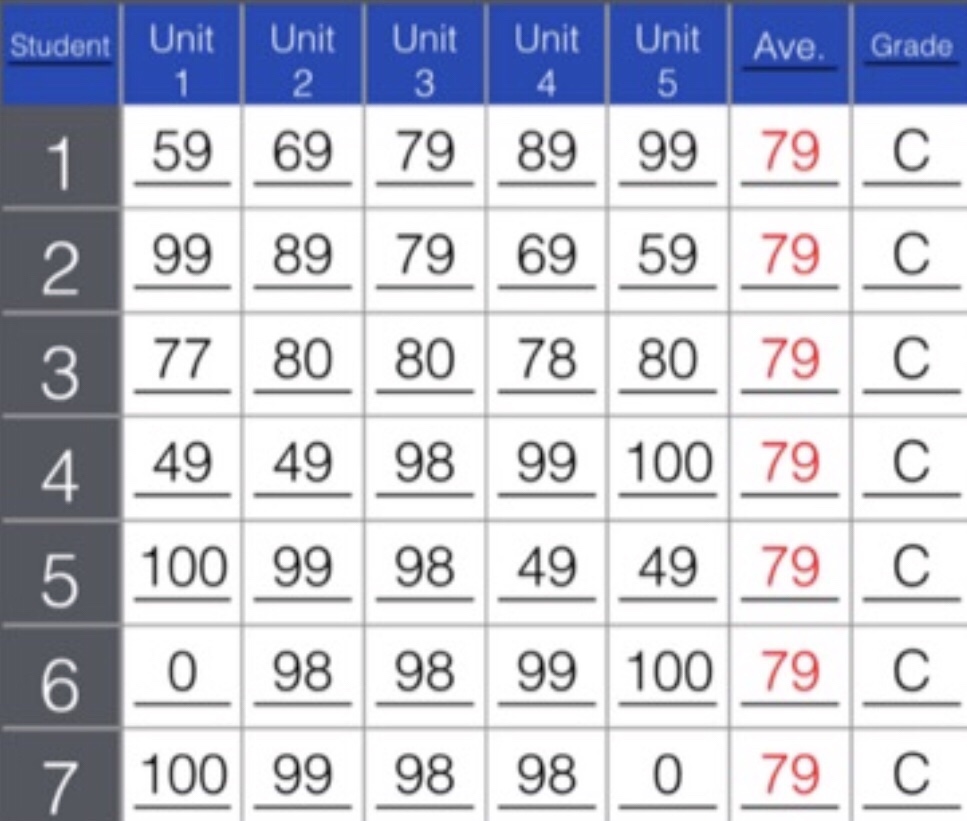This fall will mark my fourth straight (full) academic semester in which all my courses are built around standards-based grading (SBG). SBG realigns my evaluation priorities for my students from tasks, points, and weights to standards, mastery, and bundles. My favorite illustration of the limitations of traditional grading, part of my favorite faculty workshop of the past three years, is the grade chart below.

In many math courses, the later material builds on earlier material to such a extent that a student who performs well in Unit 5 can be reasonably assumed to have mastery over Unit 1. Should that student’s grade suffer if, like the fourth student above, they were still struggling with Unit 1 when its unit exam arrived? Is a high Unit 1 grade really learning-equivalent to a high Unit 5 grade? Doesn’t traditional points-based grading make nearly every assessment high stakes and incentivize students to perform (now) rather than learn (over time)?
How does SBG work?
Generally speaking, SBG provides students with a clearly-defined set of learning “standards,” skills or tasks students have the opportunity to master in the course, and assigns grades based on the quantity of standards met, each to a uniformly high standard of quality. In other words, where traditional grades might assign a C to a student who scores 70% on every assignment (showing a tenuous mastery of everything), SBG might require that student to master – verifiably, to a reasonably high level – 70% of the course’s learning standards.
SBG and other mastery- and specifications-based grading systems have umpteen variations, as you might imagine, but one feature these systems share is that they provide multiple opportunities for a student to demonstrate mastery on each topic throughout the course. This ensures that students’ grades need not suffer if they didn’t master a topic the first time it showed up on an assessment, or even the second — through an iterative process of revision and improvement, if they demonstrate they’ve learned it by the end of the semester, that mastery is fully acknowledged in their grade.
As I tell my students, it’s more important that they learn than when they learn, or at what pace. Students in traditionally-graded courses often sweat performance tasks (“I need to get an A on the next exam!”); I want my students in SBG to sweat the course content (“I still haven’t mastered factoring trinomials!”).
Perhaps because of its particular utility in teaching courses with hierarchical content (or, I would argue, the particular injustice of traditional evaluation practices in those courses), SBG and its cousins are catching on quickly among mathematics educators. Robert Talbert moderates a busy Google+ group of SBG practitioners in many disiciplines, including some of his Grand Valley State University math colleagues. This year’s MAAthFest in Colorado included a well-attended panel discussion of SBG in the college math classroom.
Here are “Common Benefits of Using #SBG” by Megan Selbach-Allen (Stanford), Sarah Greenwald and Jill Thomley (App State), and Amy Ksir (US Naval Academy). #MasteryGrading #MAAthFest #growthmindset pic.twitter.com/3CIpAQPxFh
— Dr. Kate Owens (@katemath) August 3, 2018
SBG has begun to catch on in K-12 classrooms as well, and cottage industries of educational technology are springing up to help teachers manage their grades in new ways. (Communicating students’ progress to their parents who expect mid-semester updates on points, percentages, and letter grades is a special challenge for K-12 educators using SBG.)
My SBG origins
My own SBG journey began in Spring 2016 when I was preparing to teach real analysis for the first time at my institution – a course notorious in any math department for its unrelentingly high expectations and both technical and conceptual challenge. I knew my students would begin the semester (very!) anxiously, and many of them would struggle with some of the core course concepts all semester long. I’d been following some SBG practitioners on Twitter for some time, and after joining the Google+ group and learning from the many great examples and resources shared there (particular inspiration from Kate Owens, Joshua Bowman, Drew Lewis, and Talbert) I completely upended my grading practices overnight.
Or, more accurately, over a great many nights. SBG-ifying a course that was a new prep was a good challenge for me. Like my students, I was forced to think first about the learning standards and outcomes of the course. In each chapter of content, what did I really need to see my students do that would convince me they’ve mastered that content? I divided the standards into two tiers: core standards, which every student who passes the course must master, and additional standards, which students reaching for higher levels of achievement could master. And only then did I think about learning tasks. What are the (many) ways in which students could demonstrate mastery of these standards? How to create flexibility both in type of activity – out-of-class versus in-class, problem- versus proof-based, etc. – and in time of activity, where a structured practice of revisions would permit students to continue wrestling with concepts until they mastered them without risking their grade by being “too slow.”
And with some beginner’s luck it went really well that first semester. Students reported that the conversations we had about the grading system in the first weeks of the course alleviated some anxiety. I’d like to think that it also shifted students’ perception of me as an evaluator: less a judge and more a coach. That’s what I want for my teaching — indeed, one of the main reasons I’ve stuck with SBG is that I believe this method of evaluation is in alignment with my teaching philosophy. Plus, it rids me of the angst of arbitrating, in the depths of my mid-semester grading grotto, between C-level performance and B-level performance on each individual problem in each individual assignment for each individual student. That’s not mastery grading – that’s mystery grading.
I think #mysterygrading describes how I used to assign points to student work before I adopted #masterygrading.
"Why did this get 7/10 instead of 8/10?"
"It's a myyyystery!" 👻👻 https://t.co/wb1OcAyRh5— Matt Salomone (@matthematician) August 24, 2018
Now, with a clear standard of mastery in hand, grading comes down to one question. Do I believe the student’s work demonstrates understanding of the standard? Or do I believe they need additional time and instruction?
Academics should be used to this kind of evaluation. After all, this is what we do for one another as reviewers. Does the article meet our standards of quality and significance that merits a recommendation to publish? Or should the author revise and resubmit? And if so, what must they do to improve their work for next time?
When you evaluate students on standards, grading isn’t about assigning grades. It’s about giving feedback to help students improve. (After all, number and letter grades actually inhibit students’ attention to feedback and, in my view, therefore inhibit learning. If you want students to read and heed your comments, the worst thing you can do is also add a grade at the top line!) That’s not an easy shift to make. It takes significantly more grading time: a petulant pen-scratch and a fraction are much quicker to write on a student’s paper than a sentence. But if students’ learning and not their performance is what’s at stake in my course, then what I write on students’ papers needs to be maximally useful to them, not to me.
In the next post I’ll share some of my syllabi from SBG courses, and talk about my plans for the upcoming fall semester.

One Reply to “Standards-Based Grading: Origins”